西方建筑文化英文
- 格式:pptx
- 大小:7.27 MB
- 文档页数:22

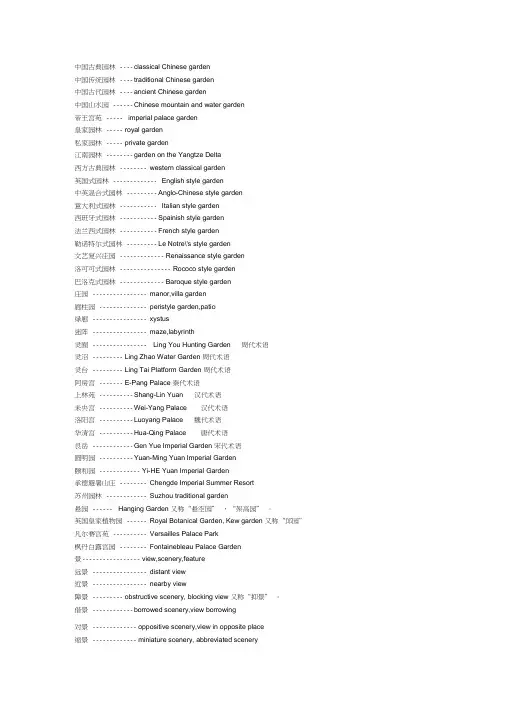
中国古典园林---- c lassical Chinese garden中国传统园林---- t raditional Chinese garden中国古代园林---- a ncient Chinese garden中国山水园------ C hinese mountain and water garden帝王宫苑----- imperial palace garden皇家园林----- royal garden私家园林----- private garden江南园林-------- g arden on the Yangtze Delta西方古典园林-------- western classical garden英国式园林------------- English style garden中英混合式园林--------- Anglo-Chinese style garden意大利式园林----------- Italian style garden西班牙式园林----------- Spainish style garden法兰西式园林----------- French style garden勒诺特尔式园林--------- Le Notre\'s style garden文艺复兴庄园------------- Renaissance style garden洛可可式园林--------------- Rococo style garden巴洛克式园林------------- Baroque style garden庄园---------------- manor,villa garden廊柱园-------------- peristyle garden,patio绿廊---------------- xystus迷阵---------------- maze,labyrinth灵囿---------------- Ling You Hunting Garden 周代术语灵沼--------- Ling Zhao Water Garden 周代术语灵台--------- Ling Tai Platform Garden 周代术语阿房宫------- E-Pang Palace 秦代术语上林苑---------- S hang-Lin Yuan 汉代术语未央宫---------- W ei-Yang Palace 汉代术语洛阳宫---------- L uoyang Palace 魏代术语华清宫---------- H ua-Qing Palace 唐代术语艮岳------------ G en Yue Imperial Garden 宋代术语圆明园---------- Y uan-Ming Yuan Imperial Garden颐和园------------ Yi-HE Yuan Imperial Garden承德避暑山庄-------- Chengde Imperial Summer Resort苏州园林------------ Suzhou traditional garden悬园------ Hanging Garden 又称“悬空园” ,“架高园” 。
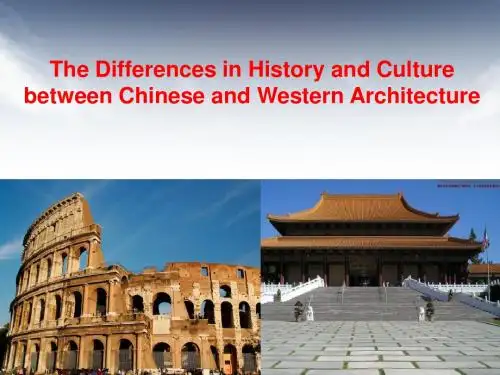
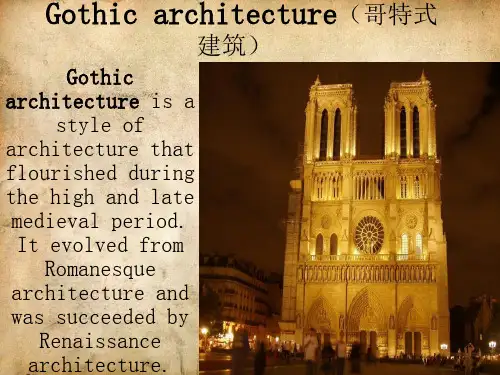
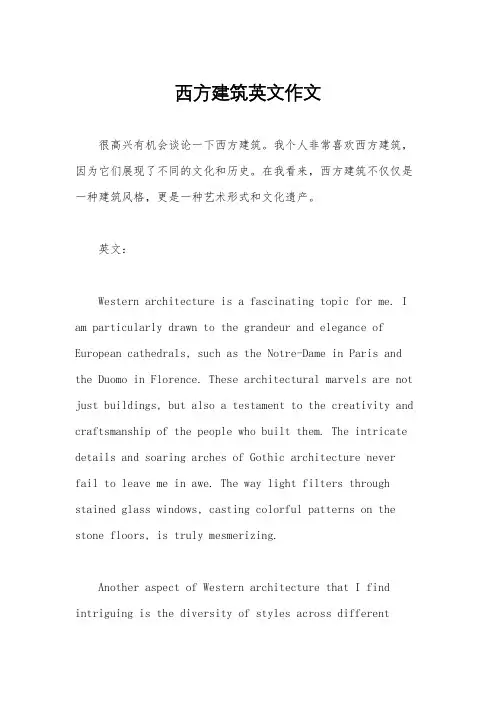
西方建筑英文作文很高兴有机会谈论一下西方建筑。
我个人非常喜欢西方建筑,因为它们展现了不同的文化和历史。
在我看来,西方建筑不仅仅是一种建筑风格,更是一种艺术形式和文化遗产。
英文:Western architecture is a fascinating topic for me. I am particularly drawn to the grandeur and elegance of European cathedrals, such as the Notre-Dame in Paris and the Duomo in Florence. These architectural marvels are not just buildings, but also a testament to the creativity and craftsmanship of the people who built them. The intricate details and soaring arches of Gothic architecture never fail to leave me in awe. The way light filters through stained glass windows, casting colorful patterns on the stone floors, is truly mesmerizing.Another aspect of Western architecture that I find intriguing is the diversity of styles across differentregions and time periods. For example, the classical columns and symmetry of Greek and Roman architecture convey a sense of order and harmony, while the ornate decorations and flamboyant designs of Baroque and Rococo buildings in France and Italy are a celebration of opulence and extravagance. Each style tells a unique story about the society and culture in which it emerged, and I find it fascinating to unravel these stories through the study of architecture.中文:西方建筑对我来说是一个非常迷人的话题。
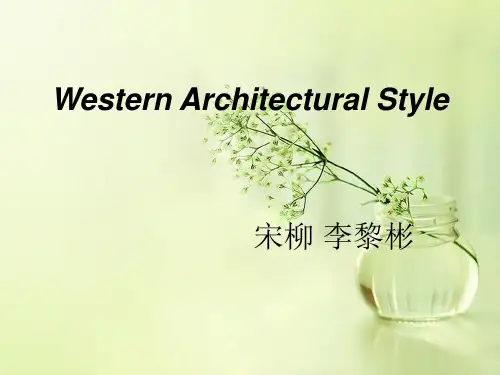
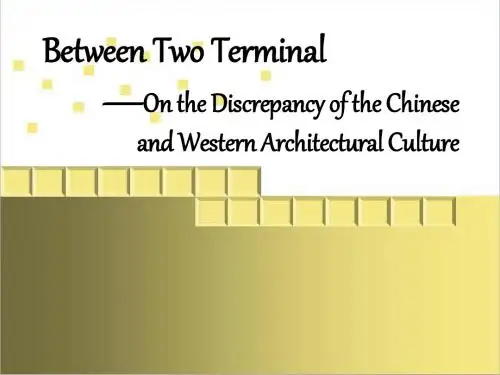
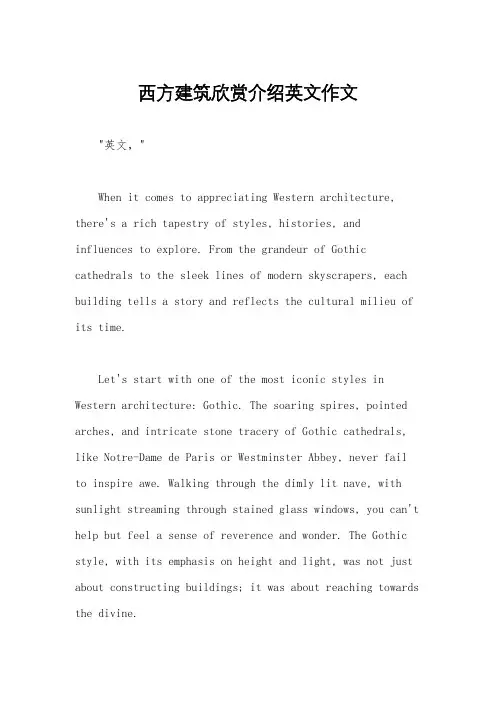
西方建筑欣赏介绍英文作文"英文,"When it comes to appreciating Western architecture, there's a rich tapestry of styles, histories, and influences to explore. From the grandeur of Gothic cathedrals to the sleek lines of modern skyscrapers, each building tells a story and reflects the cultural milieu of its time.Let's start with one of the most iconic styles in Western architecture: Gothic. The soaring spires, pointed arches, and intricate stone tracery of Gothic cathedrals, like Notre-Dame de Paris or Westminster Abbey, never fail to inspire awe. Walking through the dimly lit nave, with sunlight streaming through stained glass windows, you can't help but feel a sense of reverence and wonder. The Gothic style, with its emphasis on height and light, was not just about constructing buildings; it was about reaching towards the divine.Moving forward in time, we encounter the elegance of Renaissance architecture. Think of the symmetrical facades, domed roofs, and harmonious proportions of buildings like the Florence Cathedral or the St. Peter's Basilica in Vatican City. These structures embody the humanist ideals of balance, beauty, and rationality championed during the Renaissance period. Standing in front of the majestic dome of Florence Cathedral, designed by Brunelleschi, one can appreciate the ingenuity and skill of the architects ofthat era.Fast forward to the present day, and we find ourselves amidst the glass and steel jungle of modern architecture. Skyscrapers like the Empire State Building in New York or the Shard in London redefine our urban landscapes, pushing the boundaries of engineering and design. The sleek lines and futuristic forms of these buildings symbolize progress and innovation, reflecting the fast-paced nature of contemporary society.But it's not just the monumental structures thatcapture our imagination. Western architecture also encompasses charming townhouses, quaint cottages, and cozy cafes nestled along cobblestone streets. Whether it's the colorful facades of Amsterdam's canal houses or the charming balconies of Barcelona's Gothic Quarter, these smaller-scale buildings add character and warmth to their surroundings.In conclusion, Western architecture offers a diverse range of styles and influences, each with its own unique appeal. From the grandeur of Gothic cathedrals to the elegance of Renaissance palaces to the innovation of modern skyscrapers, there's something for everyone to appreciate and admire."中文,"谈到欣赏西方建筑,其中蕴含了丰富的风格、历史和影响。
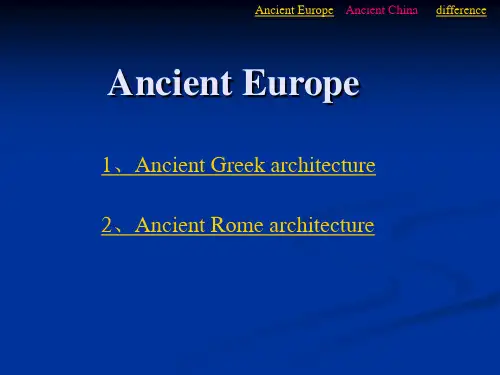
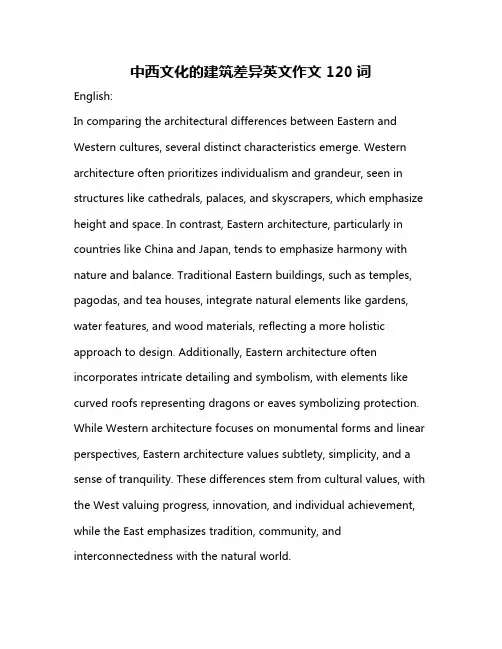
中西文化的建筑差异英文作文120词English:In comparing the architectural differences between Eastern and Western cultures, several distinct characteristics emerge. Western architecture often prioritizes individualism and grandeur, seen in structures like cathedrals, palaces, and skyscrapers, which emphasize height and space. In contrast, Eastern architecture, particularly in countries like China and Japan, tends to emphasize harmony with nature and balance. Traditional Eastern buildings, such as temples, pagodas, and tea houses, integrate natural elements like gardens, water features, and wood materials, reflecting a more holistic approach to design. Additionally, Eastern architecture often incorporates intricate detailing and symbolism, with elements like curved roofs representing dragons or eaves symbolizing protection. While Western architecture focuses on monumental forms and linear perspectives, Eastern architecture values subtlety, simplicity, and a sense of tranquility. These differences stem from cultural values, with the West valuing progress, innovation, and individual achievement, while the East emphasizes tradition, community, and interconnectedness with the natural world.Translated content:在比较东西方文化建筑的差异时,几个明显的特点浮现出来。
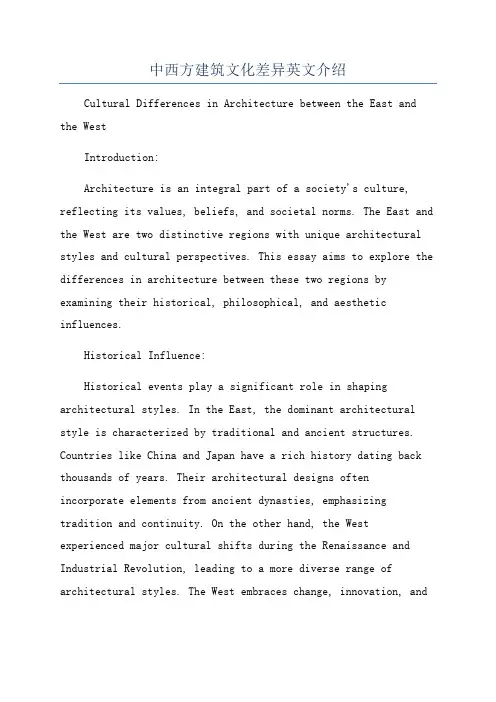
中西方建筑文化差异英文介绍Cultural Differences in Architecture between the East and the WestIntroduction:Architecture is an integral part of a society's culture, reflecting its values, beliefs, and societal norms. The East and the West are two distinctive regions with unique architectural styles and cultural perspectives. This essay aims to explore the differences in architecture between these two regions by examining their historical, philosophical, and aesthetic influences.Historical Influence:Historical events play a significant role in shaping architectural styles. In the East, the dominant architectural style is characterized by traditional and ancient structures. Countries like China and Japan have a rich history dating back thousands of years. Their architectural designs often incorporate elements from ancient dynasties, emphasizing tradition and continuity. On the other hand, the West experienced major cultural shifts during the Renaissance and Industrial Revolution, leading to a more diverse range of architectural styles. The West embraces change, innovation, andindividualism, leading to a mix of classical and contemporary architectural designs.Philosophical Influence:Aesthetic Influence:Cultural aesthetics also contribute to the differences in architecture between the East and the West. Eastern architecture focuses on symbolism and spiritual meanings. Traditional Chinese and Japanese architecture utilize specific elements and patterns to convey cultural values and beliefs. For example, the Chinese use the dragon motif to symbolize power and strength, while the Japanese employ the concept of wabi-sabi, embracing imperfection and transience. In the West, aesthetics are often based onvisual appeal and form. The emphasis is on proportion, symmetry, and visual harmony. Elaborate ornamentation, grandeur, and opulence are often associated with Western architectural styles.Urban Planning and Space:Conclusion:The architectural differences between the East and the West can be attributed to historical, philosophical, and aesthetic factors. The East emphasizes tradition, harmony with nature, and symbolism, resulting in designs that convey a sense oftranquility and spirituality. In contrast, the West values progress, individualism, and visual appeal, resulting inarchitectural styles that prioritize functionality and grandeur. These differences reflect the unique cultural perspectives of each region and contribute to the diverse architectural landscape we see today.。
介绍西方建筑英文作文Western architecture is characterized by its diverse styles and influences, ranging from classical Greek and Roman designs to modernist and postmodernist structures. The use of materials such as stone, glass, and steel allows for innovative and striking designs that stand out in urban landscapes.One of the most iconic features of Western architecture is the use of columns and arches, which can be seen in buildings such as the Parthenon in Greece and the Colosseum in Rome. These architectural elements not only provide structural support but also add a sense of grandeur and elegance to the overall design.In contrast to the ornate details of classical architecture, modern Western buildings often feature clean lines, minimalist designs, and large windows that allow for natural light to filter through. This emphasis onsimplicity and functionality reflects the shift towards amore contemporary aesthetic in architectural trends.Postmodern architecture, on the other hand, embraces eclecticism and experimentation, combining elements from different styles and time periods to create visually dynamic and unconventional buildings. This approach challenges traditional notions of form and function, pushing the boundaries of what is considered "good" design.Overall, Western architecture is a reflection of the cultural, historical, and technological advancements of the societies in which it emerges. From ancient temples to futuristic skyscrapers, each building tells a story of innovation, creativity, and the ever-evolving nature of architectural design.。
草图Draft drawing/sketch平面Plan总平面master plan剖面Section立面Elevation正立面Facade透视图Perspective轴测图Axonometric view示意图/分析图Diagram地图分析/制图mapping/ mapping diagram图表chart/table容积率floor area ratio覆盖率Coverage城市设计Urban design; civic design区域规划Regional planning总体规划comprehensive planning/ master planning/ overall planning 分区规划District planning/ zoning act控制性详细规划Regulatory Plan修建性详细规划Site planning (constructive-detailed planning)场地规划Site planning近期建设规划Immediate planning步行轴Walking axis概念设计conceptual design方案设计schematic design扩初设计design development详细设计、细部设计Detail Design城市化Urbanization城市生态Urban ecology城市农业urban farming/ urban agriculture经济能量来源Economy energy sources可持续发展Sustainable development历史性城市的保护规划Preservation Plan of historic cities旧城更新、改造-Urban Regeneration/Urban Revitalization/Retrofitting Plan城市再开发-Urban Redevelopment开发区Development area城市化水平Urbanization level城市群Urban Agglomeration/ Metropolitan Area/ Metropolitan Coordinating Region/mega region 城市系统Urban system卫星城市(城镇)Satellite town/ affiliate township城市基础设施Urban infrastructure市政基础设施Municipal Infrastructure绿色基础设施Green Infrastructure生态基础设施Ecological Infrastructure居民点Settlement城市City市Municipality; city城镇Town城市管理区域Administrative region of a city商业区Commercial district民政区域Civil district居住区规划Residential area planning护林区Ranger district绿地Percentage of greenery coverage绿化覆盖率Ratio of green space绿地率Landscaping within factory工厂绿化Landscaping of square广场绿化Landscaping of residential area居住区绿化Improved vegetation & wildlife谷底植栽场Landscaping around public building公共建筑绿化Indoor garden室外绿化Urban green 城市绿化Urban green space system城市绿化系统Public green space公共绿地Park公园Green belt 绿地Specified green space专用绿地Green buffer防护绿地空间(建筑)Parlor客厅Washroom; toilet卫生间、洗手间Balcony阳台、包厢Bathroom浴室Cabinet橱柜Courtyard building庭院建筑Dining-room ; dining hall餐厅Entrance入口Kitchen厨房Roof屋顶Kid room儿童房Dollhouse儿童游乐室Living room起居室Pavilion亭、阁Private garden私家花园Resident住宅Shared zone共享空间Toilet洗手间Servants hall用人房Scale比例Element要素、自然环境conference center会议中心Retail shop零售商店Theatre剧院园林景观Arbor乔木Shrub灌木Band stone铺石Car park below地下车库Carved paving bands曲线形铺地Cartilage Garth 庭园Courtyard identification sign标志牌Courtyard 庭院Fall瀑布Feature景色Footpath步道Garden bridge园桥Garden and park园林Herbage草本植物Liana藤本植物Natural cut stone砌石Pave铺地Pavilion 亭、阁Pavilion on terrace榭Planting植被Planting beds 花坛Plaza大广场Platform台Deck promenade栈道Pole lights灯柱Pool小水池Sculpture雕塑常用的景观英文参考1.主入口大门/岗亭(车行& 人行)MAIN ENTRANCE GATE/GUARD HOUSE main entrance gate/guard house (FOR VEHICLE& PEDESTRIAN ) for vehicle& pedestrian2.次入口/岗亭(车行& 人行)2ND ENTRANCE GATE/GUARD HOUSE 2nd entrance gate/guard house (FOR VEHICLE& PEDESTRIAN )3.商业中心入口ENTRANCE TO SHOPPING CTR. Entrance to shopping ctr.4.水景WATER FEATURE water feature5.小型露天剧场MINI AMPHI-THEATRE mini amphitheatre6.迎宾景观-1WELCOMING FEATURE-1 welcoming feature-17.观景木台TIMBER DECK (VIEWING) timber deck (viewing)8.竹园BAMBOO GARDEN bamboo garden9.漫步广场WALKWAY PLAZA walkway plaza10.露天咖啡廊OUT DOOR CAFE out door cafe11.巨大迎宾水景-2GRAND WELCOMING FEATURE-2 grand welcoming feature-2 12.木桥TIMBER BRIDGE timber bridge13.石景、水瀑、洞穴、观景台ROCK'SCAPE WATERFALL'S rock's cape waterfall's GROTTO/ VIEWING TERRACE grotto/ viewing terrace14.吊桥HANGING BRIDGE hanging bridge15.休憩台地(低处)LOUNGING TERRACE (LOWER ) lounging terrace (lower ) 16.休憩台地(高处)LOUNGING TERRACE (UPPER ) Lounging terrace (upper ) 17.特色踏步FEATURE STEPPING STONE feature stepping stone18.野趣小溪RIVER WILD river wild19.儿童乐园CHILDREN'S PLAYGROUND children's playground20.旱冰道SLIDE Slide21.羽毛球场BADMINTON COURT badminton court 网球场Tennis court 22.旱景DRY LANDSCAPE dry landscape23.日艺园JAPANESE GARDEN Japanese garden24.旱喷泉DRY FOUNTAIN dry fountain25.观景台VIEWING DECK viewing deck26.游泳池SWIMMING POOL swimming pool27.极可意JACUZZI Jacuzzi28.嬉水池WADING POOL wading pool29.儿童泳池CHILDREN'S POOL children's pool30.蜿蜒水墙WINDING WALL winding wall31.石景雕塑ROCK SCULPTURE rock sculpture32.中心广场CENTRAL PLAZA central plazaEXERCISE PLAZA exercise plaza34.桥BRIDGE bridge35.交流广场MEDITATING PLAZA meditating plaza36.趣味树阵TREE BATTLE FORMATION tree battle formation37.停车场PARING AREA paring area38.特色花架TRELLIS trellis39.雕塑小道SCULPTURE TRAIL sculpture trail40.(高尔夫)轻击区PUTTING GREEN putting green41.高尔夫球会所GOLF CLUBHOUSE golf clubhouse42.每栋建筑入口ENTRANCE PAVING TO UNIT entrance paving to unit43.篮球场BASKETBALL COURT basketball court44.网球场TENNIS COURT tennis court45.阶梯坐台/种植槽TERRACING SEATWALL/PLANTER terracing seat wall / planter 46.广场MAIN PLAZA main plaza47.森林、瀑布FOREST GARDEN WATERFALL forest garden waterfall48.石景园ROCKERY GARDEN rockery garden49.旱溪DRY STREAM dry stream50.凉亭PAVILION Pavilion51.户外淋浴OUTDOOR SHOWER outdoor shower52.拉膜结构TENSILE STRUCTURE tensile structure53.台阶STAIR stair54.高尔夫球车停车场PARKING ( GOLF CAR ) parking ( golf car )EXERCISE STATION exercise station56.晨跑小路JOGGING FOOTPATH jogging footpath57.车道/人行道DRIVEWAY /SIDEWALK driveway /sidewalk58.人行漫步道PROMENADE promenade59.瀑布及跳舞喷泉(入口广场)WATER FALL AND DANCING water fall and dancing FOUNTAIN ( ENTRY PLAZA ) fountain ( entry plaza )60.特色入口ENTRY FEATURE entry feature61.石景广场ROCKERY PLAZA rockery plaza中国古典园林------classical Chinese garden中国传统园林-------traditional Chinese garden中国古代园林-------ancient Chinese garden中国山水园----------Chinese mountain and water garden帝王宫苑--------- imperial palace garden皇家园林----------royal garden私家园林-----------private garden江南园林--------------garden on the Yangtze Delta西方古典园林---------------western classical garden英国式园林-------------------- English style garden中英混合式园林--------------Anglo-Chinese style garden意大利式园林------------------ Italian style garden西班牙式园林----------------Spanish style garden法兰西式园林------------------French style garden勒诺特尔式园林---------------Le Notre's style garden文艺复兴庄园--------------------Renaissance style garden洛可可式园林-----------------------Rococo style garden巴洛克式园林---------------------Baroque style garden庄园--------------------------manor, villa garden廊柱园-----------------------peristyle garden, patio绿廊----------------------------xystus迷阵-----------------------------maze, labyrinth灵囿-------------------------- Ling You Hunting Garden 周代术语灵沼---------------Ling Zhao Water Garden 周代术语灵台---------------Ling Tai Platform Garden 周代术语阿房宫-------------E-Pang Palace 秦代术语上林苑---------------Shang-Lin Yuan 汉代术语未央宫---------------Wei-Yang Palace 汉代术语洛阳宫----------------Luoyang Palace 魏代术语华清宫----------------Hua-Qing Palace 唐代术语艮岳-------------------Gen Yue Imperial Garden 宋代术语圆明园----------------Yuan-Ming Yuan Imperial Garden颐和园-------------------Yi-HE Yuan Imperial Garden承德避暑山庄---------------Chengde Imperial Summer Resort苏州园林----------------------Suzhou traditional garden悬园----------- Hanging Garden 又称“悬空园”,“架高园”。
中西建筑文化差异英语作文50词英文回答:In terms of architectural styles, there are distinct differences between Western and Eastern cultures. Western architecture is characterized by its focus on symmetry, geometric forms, and a strong emphasis on functionality. Buildings in the West often have a grand and imposing appearance, with intricate facades and elaborate ornamentation. Examples of Western architectural styles include Gothic, Baroque, and Neoclassical.Eastern architecture, on the other hand, is more influenced by nature and the surrounding environment. Buildings are typically designed to harmonize with their surroundings, and they often feature curved lines, organic shapes, and natural materials such as wood and stone. Eastern architectural styles include Chinese, Japanese, and Islamic.Another key difference between Western and Eastern architecture is the way in which space is used. Western buildings tend to compartmentalize space into separate rooms, while Eastern buildings often have a more fluid and open layout, with spaces flowing into one another. This difference in spatial organization reflects the different cultural values of the two societies.Finally, the materials used in construction also differ between Western and Eastern architecture. Western buildings are often made of stone, brick, and concrete, while Eastern buildings may also incorporate materials such as bamboo, wood, and paper. These differences in materials reflect the different climates and resources available in the two regions.中文回答:中西建筑文化的差异。
中西方的建筑文化差异举例英语作文英文回答:Architecture: A Cross-Cultural Comparison.Architecture, as a reflection of the cultural, historical, and socio-economic context in which it is created, exhibits significant variations across different regions and civilizations. A comparative analysis of Western and Eastern architectural traditions reveals a fascinating array of dissimilarities in form, function, aesthetics, and underlying philosophies.Form and Function.Western architecture is often characterized by its emphasis on geometric shapes, symmetry, and imposing verticality. Buildings tend to be tall and imposing, with elaborate facades adorned with intricate details. Western architecture often places a premium on aesthetics andvisual grandeur, with buildings designed to convey power, wealth, or cultural significance. In contrast, Eastern architecture is more likely to favor organic forms, curved lines, and horizontal expansion. Buildings are typically more low-rise and integrated into the surrounding landscape. Eastern architecture emphasizes functionality and harmony with nature, with buildings designed to provide shelter, comfort, and a sense of tranquility.Materials and Construction.Western architecture has historically relied heavily on stone, brick, and metal as primary building materials. These materials allow for the construction of durable and fire-resistant structures, but they can also be expensive and resource-intensive. Eastern architecture, on the other hand, has traditionally utilized lighter materials such as wood, bamboo, and paper. These materials are more readily available and environmentally sustainable, but they may not be as durable or resistant to fire.Aesthetic Considerations.Western architecture often embodies principles of classical aesthetics, with an emphasis on proportion, balance, and symmetry. Buildings are frequently adornedwith decorative elements, such as columns, arches, and pediments, which serve both aesthetic and symbolic purposes. In contrast, Eastern architecture tends to emphasize simplicity, minimalism, and asymmetry. Buildings are designed to blend harmoniously with their natural surroundings, and ornamentation is typically restrained and understated.Cultural and Philosophical Influences.Western architectural traditions have been strongly influenced by the rise of Christianity and the developmentof urban centers. Cathedrals and other religious buildings played a central role in shaping the architectural landscape, and their design often reflected the power and authority of the Church. In contrast, Eastern architectural traditions have been influenced by Buddhism, Taoism, and Confucianism. These philosophies emphasize harmony withnature, balance, and the interconnectedness of all things. Eastern architecture reflects these beliefs through its focus on natural materials, organic forms, and integration with the surrounding landscape.Contemporary Trends.In recent decades, there has been a growing convergence between Western and Eastern architectural styles. Contemporary architects are increasingly blending elements from both traditions to create innovative and sustainable designs. Western architects are incorporating more organic forms and natural materials into their buildings, while Eastern architects are experimenting with modern construction techniques and materials. This cross-cultural exchange is fostering a new era of architectural expression that transcends traditional boundaries.中文回答:建筑,东西方文化差异。